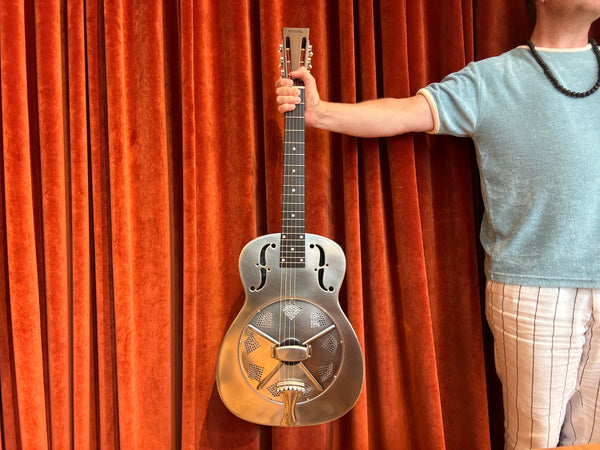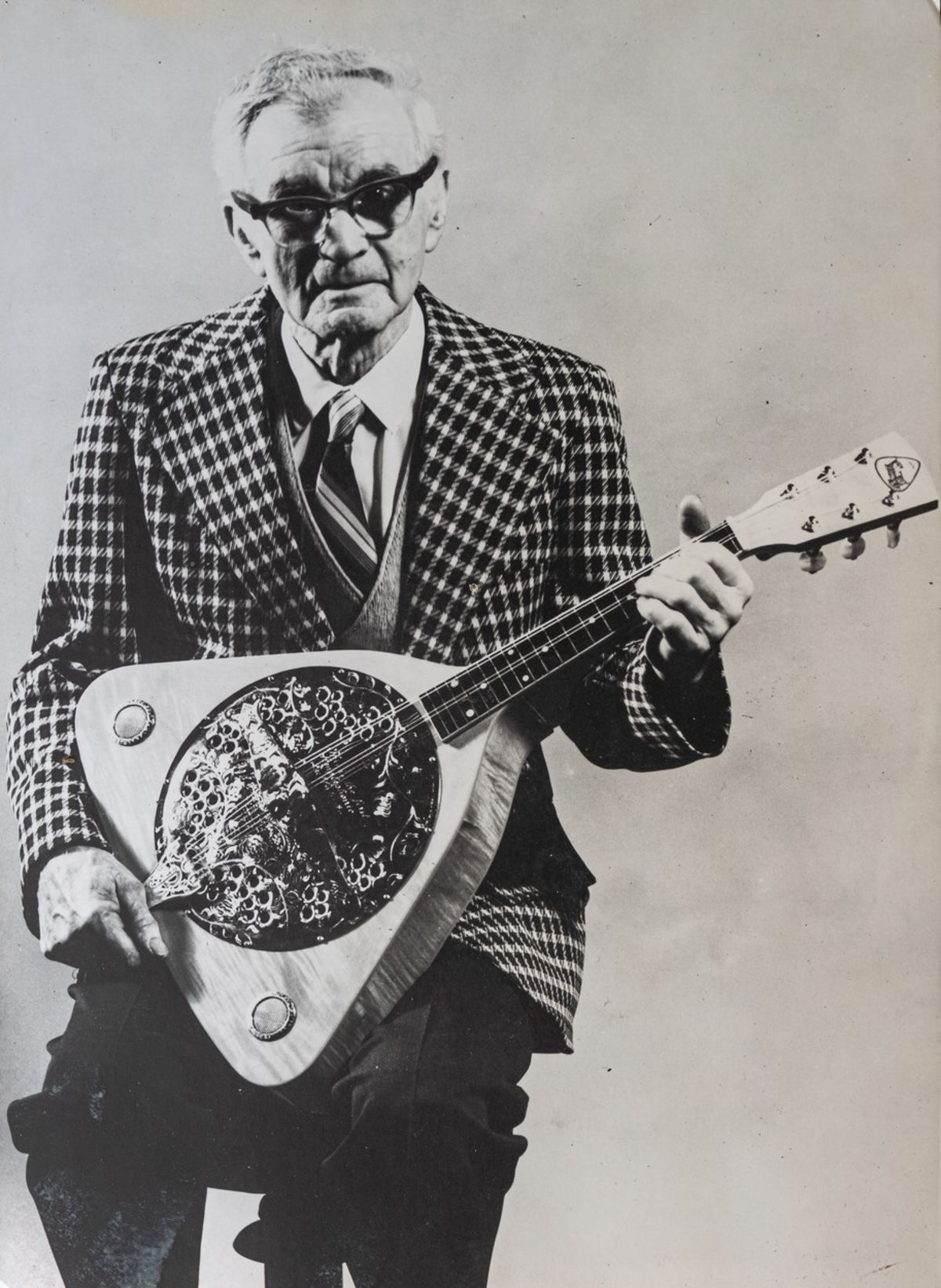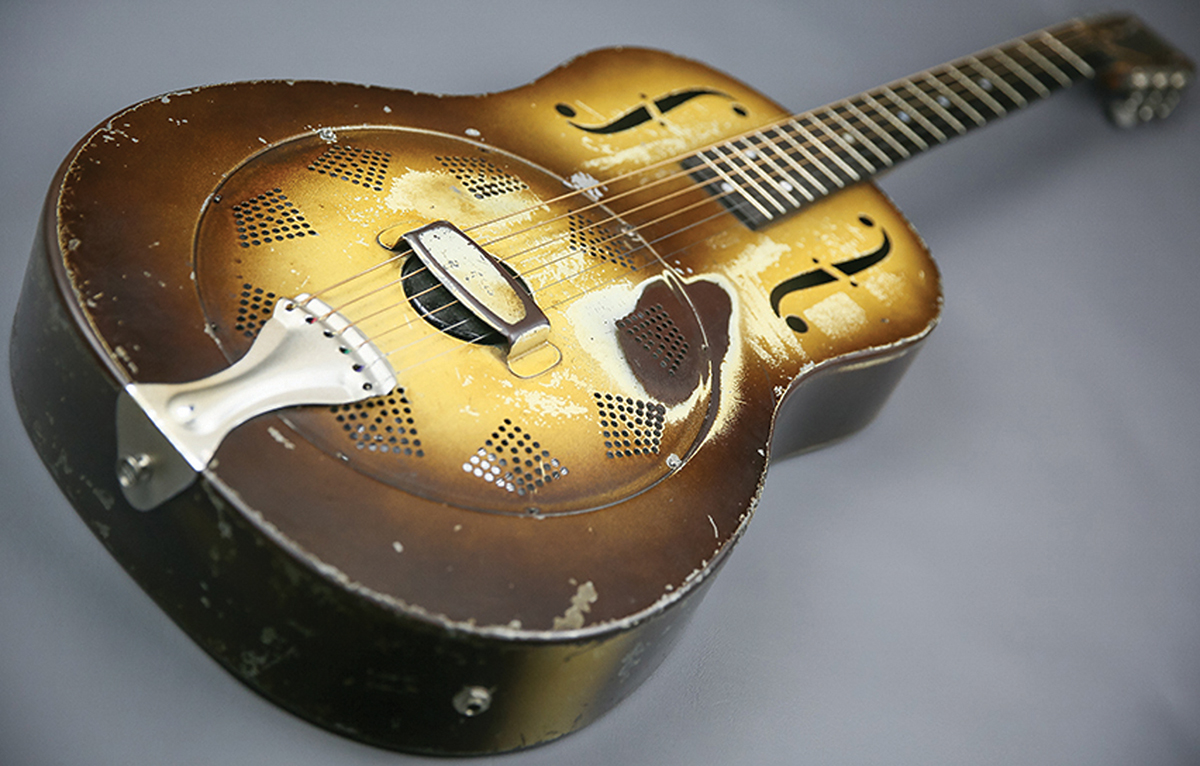
...Shining Like a National Guitar.
Founded in 1927, National Guitars were first marketed as 'Res-o-phonic Guitars' and were designed by John Dopyera and George Beauchamp. Beauchamp - a steel guitar player was looking for a louder guitar to play single note lead lines that could cut above brass instruments. In the 1920s the popular music was Big Band style jazz and if the guitar was going to move with these times, it needed to keep up in the volume race. At the time of Beauchamp's request, Dobyera was a violin technician but once tasked with the innovation of the six string instrument he dove in head first. After an aborted attempt to realise a burgeoning Beauchamp design, Dopyera started experimenting with various materials and came to rest on a thin aluminium cone, attaching it to the bridge saddle and mounting it inside the guitar.

John Dopyera holding what looks like a resonator Ozark.
The guitar was indeed louder than the wooden guitars of the time, but it wasn't harmonically well balanced until he started experimenting with a tri-cone design. Three of Dopyera's aluminium cones were laid out within the body of the guitar and topped with a t-bar bridge design that extended to the centre of each cone. When struck, the vibration of the strings is transferred to the centre of each cone and this energy is converted to sound that features some heavily metallic tones.
![]()
The patent filed for the Tricone design by John Dopyera in 1927
Patents were acquired, investors found and production was begun on the futuristic/art deco looking guitars. The single cone design was developed further during the depression era as it was more affordable to produce. Both the single cone Duolian and Triolian models were popular with the travelling blues players as they were both loud and a rugged road companion.

A 1932 National Triolian from Greenwoods Music in Liverpool.
Resonator guitars (as they became known) have been used in various genres over the years, but are probably most associated with Hawaiian slide playing and as previously mentioned, the Blues. Notable musicians such as Son House, Sol Ho’opi’i, Rosetta Thorpe and Memphis Mini have all used the instrument to great effect.

Son House with A National Duolian. Photo by Lynn Alder.
Internal issues between the two founders of National mounted and Dobyera sold his stocks in the company only two years into the venture - he and Beauchamp were poles apart individually, and Dopyera went on to form a rival company with his brothers called Dobro. Lawsuits and acquisitions were afoot between the two companies and somewhere along the way a chap named Adolf Rickenbacker became involved and helped Beauchamp develop the world's first electric guitar, the Rickenbacker A-22 lap steel guitar. Eventually Dobro and National merged and in 1940 was renamed Valco, a company that made instruments and amplifiers under various names (and still continuing with National) including the popular amplifier range, Supro.
National and resonator guitars in general have continued to permeate through popular culture over the years thanks to the ongoing interest in the pioneering blues artists. Name drops always help too and Paul Simon offers a huge one in his quintessential song Graceland, the opening lyrics being "The Mississippi Delta was shining like a National guitar". Another nod (also released in 1986) coming on the cover of Dire Strait's watershed album 'Brothers in Arms', a National Style O 14th fret resonator can be seen hanging against a blue sky. If you were a music fan in those days then this image will be etched into your memory, regardless of what you think of the album.

The cover of Dire Straits stone cold classic, Brothers in Arms.
In 1989 the company name was reissued and National Reso-phonic began production once again in California, using the tried and true materials and techniques that made them so unique back in the late 1920s. Studio 1 has just received our first shipment of these supremely crafted instruments and boy or boy, they do not disappoint. As soon as you pick one up and pluck a note you are transported to a time gone by. The rich history of the blues is at your fingertips with a National Res-o-phonic guitar, come and try one today.
